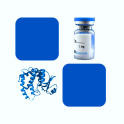
- Remove this product from my favorite's list.
- Add this product to my list of favorites.
Products
Newsletter
 |  |  |  |  |  |

Background
Cell Adhesion Molecules (CAMs) are proteins located on the cell surface involved with the binding with other cells or with the extracellular matrix (ECM) in the process called cell adhesion. Cell adhesion molecule 1 is a single-pass type I membrane protein which belongs to the nectin family. Cell Adhesion Molecule 1 contains two Ig-like C2-type (immunoglobulin-like) domains and one Ig-like V-type (immunoglobulin-like) domain, and is also known as CADM1; BL2; DKFZp686F1789; IGSF4; IGSF4A; MGC149785; MGC51880; NECL2; Necl-2; RA175; ST17; SYNCAM; TSLC1; sTSLC-1; sgIGSF; synCAM1. CADM1 mediates heterophilic cell-cell adhesion with CADM3 and PVRL3 in a Ca2+-independent manner. CADM1 acts as a tumor suppressor in non-small-cell lung cancer (NSCLC) cells. CADM1 may be involved in neuronal migration, axon growth, pathfinding, and fasciculation on the axons of differentiating neurons. CADM1 may play diverse roles in the spermatogenesis including in the adhesion of spermatocytes and spermatids to Sertoli cells and for their normal differentiation into mature spermatozoa.
Source
Recombinant Human CADM1 Protein (rhCADM1), His Tag (CA1-H5225) is expressed from human 293 cells (HEK293). It contains AA Gln 45 - His 374 (Accession # NP_055148.3).
Predicted N-terminus: Gln 45
Molecular Characterization
This protein carries a polyhistidine tag at the C-terminus.
The protein has a calculated MW of 37.9 kDa. The protein migrates as 50 kDa and 55-85 kDa under reducing (R) condition (SDS-PAGE) due to different glycosylation.
Endotoxin
Less than 1.0 EU per μg by the LAL method.
Purity
>95% as determined by SDS-PAGE.
Formulation
Lyophilized from 0.22 μm filtered solution in PBS, pH7.4 with trehalose as protectant.
Reconstitution
Please see Certificate of Analysis for specific instructions.
For best performance, we strongly recommend you to follow the reconstitution protocol provided in the CoA.
Storage
For long term storage, the product should be stored at lyophilized state at -20°C or lower.
Please avoid repeated freeze-thaw cycles.
This product is stable after storage at:
-20°C to -70°C for 12 months in lyophilized state;
-70°C for 3 months under sterile conditions after reconstitution.
Bioactivity
Please refer to product data sheet.
(1) "Prognosis of aggressive adult T-cell leukemia/lymphoma with central nervous system infiltration and utility of CD7 versus CADM1 flowcytometric plots of cerebrospinal fluid"
Jimbo, Ishigaki, Sakashita et al
Ann Hematol (2025)
(2) "Identification of selective sweep and associated QTL traits in Iranian Ovis aries and Ovis orientalis populations"
Taheri, Javadmanesh, Zerehdaran
Front Genet (2024) 15, 1414717
(3) "Identification of key genes and variants associated with boar sperm freezability using whole genome resequencing"
Wang, Bai, Wang et al
Int J Biol Macromol (2024) 294, 139268
Showing 1-3 of 613 papers.
Follow us